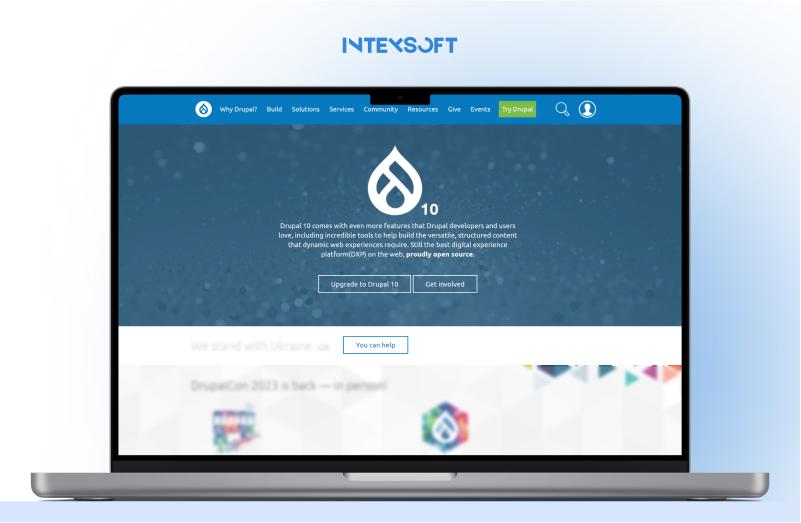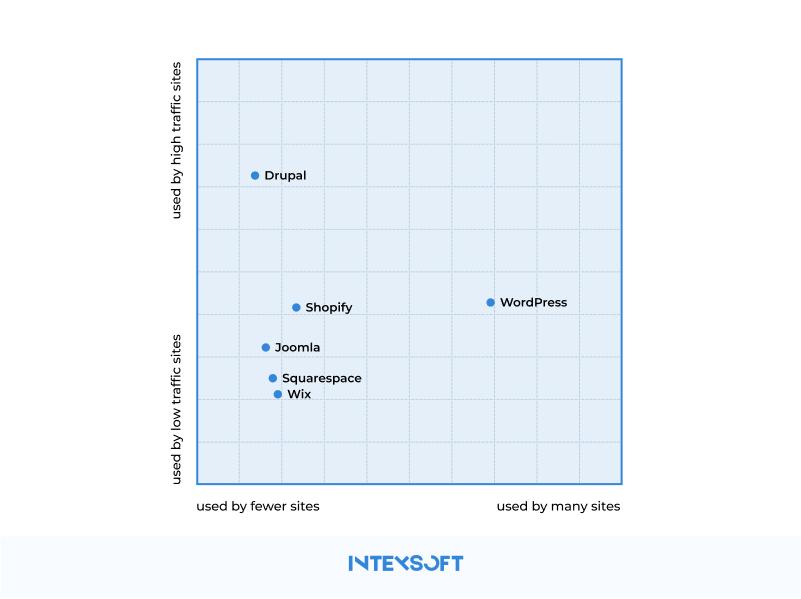

In this article, you will learn about Drupal ecommerce development, its benefits, features, and how it stands in comparison with other platforms. You will discover more about Drupal’s potential for business, get the necessary knowledge to leverage its power and create a successful online store in 2023. Get a free consultation from our experts.
Reading time: 20 min.
Drupal ecommerce development holds immense potential for store owners seeking ways to drive online business. But what is it about this platform that many developers and users love? The answer lies in the remarkable features and benefits it offers.
In this guide, IntexSoft will explore the capabilities of Drupal Commerce for stores. Get ready to uncover a world of benefits that will transform your business and steer it toward success.

Drupal Commerce is open-source software licensed under the GNU (General Public License), based on the Content Management System (CMS) Drupal. This game-changing platform performs well in labor-intensive projects with complex structures, making it a true segment leader. Drupal comes out ahead of traditional programming languages by software developers get ready-made solutions through modules, saving time and effort. This means business owners can cut costs and start making money faster. The latest version, Drupal 10, was launched four months ago, bringing new features for online stores and helping businesses to boost their profits.
Drupal Commerce has many features that wow developers, but for business owners, the focus is a little different. Here are some of the benefits an online business can hope to gain when implementing Drupal Commerce:
1. Flexibility
Drupal allows businesses to customize their stores according to unique branding, design, and functions. The platform’s modular architecture enables seamless integration of different extensions, empowering businesses to create highly engaging ecommerce experiences.
2. Scalability
Every Drupal website includes a scalable solution that can accommodate increasing traffic and transactions. Whether you are a small boutique or a large enterprise, Drupal can scale alongside your online store, ensuring smooth performance.
3. Modules
As your business grows and expands, Drupal boasts a vast library of modules, with over 46,000 options available for use. For example, your online store can extend capabilities, from payment gateways and commerce shipping options to advanced marketing tools.
4. Security
Strong security measures and frequent automatic updates deliver to keep your business and clients secure. The proactive dev community continuously monitors and addresses vulnerabilities. You can enjoy peace of mind knowing that Drupal checkout flows – data and transactions – are protected.
5. Mobile-friendly
The platform offers responsive design capabilities, ensuring your new store automatically adapts to different screen sizes – customers shop conveniently from any device. This is perfect in the mobile-first world.
6. SEO-friendly
Drupal Commerce is designed with SEO best practices in mind to offer features that facilitate optimized content creation, clean URLs, and meta tags. This helps businesses rank higher in search results to ensure your customers can find you. Your website will be addressed quickly and easily.
7. Drupal community support
This massive community offers a valuable resource pool, documentation, forums, and knowledge-sharing platforms where businesses can seek assistance, collaborate, and stay updated with the latest trends.
By harnessing these benefits, companies can leverage Drupal’s capabilities to create powerful ecommerce stores that drive customer satisfaction and long-term success.
Several popular ecommerce solutions exist – Shopify, WooCommerce (WordPress), Magento, and Joomla. But they all perform well on low-traffic websites. Only Drupal has become a leader in the high-traffic segment. To ensure this fact, check out the chart below:

When it comes to ecommerce development, four prominent players reign supreme in the digital field – Drupal Commerce, Magento, Shopify, and WooCommerce (WordPress). Each platform possesses its own unique set of pros and cons. Let’s dig deeper into each ecommerce platform individually to compare them.
Pros and cons of the most popular ecommerce platforms
| Platform | Pros | Cons |
| Drupal Commerce | Convenient control system (you can reuse the same type of content for different web pages on a Drupal site). Over 46,000 modules (you don’t need to install add-ons, extensions for any ecommerce website). 250 themes (From sleek and modern to bold and artistic, Drupal’s themes offer endless possibilities to tailor the look and feel of your store to perfection). Perfect user management system (the entire content and customer data are into a single tool; the admin panel creates access points, and user groups, so you can easily edit user rights). Additional functionality (integrations with PayPal, performance with search engines, marketing platforms, CRMs, analytics, and other services). Drupal community. | The complexity of development (only experienced developers can handle it). Lack of an intuitive CMS. The impossibility of free or cheap hosting (because Drupal has very high system requirements). |
| Magento | User-friendly customization process (you can do almost anything with your ecommerce site). SEO-optimization (you can achieve higher extension and ranking on the Google search results page). Frontend and backend management (online retailers have total control over the code, design, functionality, appearance, and website content). | Complicated installation process. Hosting on other platforms. Lack of themes (you need to hire developers to create them). |
| Shopify | 24/7 customer support (you can reach experts via chat, email, or even phone). 100 mobile-friendly storefront themes (themes are pre-designed and easy to navigate). More than 25 types of payment gateways (your customers can choose from a convenient payment option, including cryptocurrencies). | Only 10 themes are available for free (the other 90 are paid). Transaction fees for every sale are made through its dedicated payment gateway. Lack of individual Commerce product Variation (impossible to create a diverse product portfolio). |
| WooCommerce (WordPress) | Lots of website themes to choose from. Unlimited customization (you can create a unique store). SEO optimization (you can monitor ranking, performance, metadata, and well-sorted reports). | Weak customer support. Only available for ecommerce websites that use WordPress. Expensive extensions and ons (only the base program is free). |
With its robust and flexible architecture, Drupal Commerce is a prime choice for businesses seeking a customizable and scalable ecommerce solution.
Meanwhile, Magento provides companies with robust features, extensive functionality, and enterprise-level capabilities. This is well-suited for businesses with complex product catalogs, high transaction volumes, and sophisticated order management requirements. Its extensions and plugins enable enterprises to create feature-rich and highly scalable stores.

Drupal Commerce suits businesses seeking extensive customization, scalability, and a community-driven environment. With its solid foundation and extensible architecture, Drupal Commerce shines in managing complex ecommerce operations.
Meanwhile, Shopify offers an intuitive setup. This platform allows businesses to handle high-volume sales and traffic spikes without worrying about server management or technical complexities.
Drupal Commerce powers custom software development services for high-profile websites, including Tesla, Warner Music Group, and The Weather Channel. Its reputation for stability, security, and extensibility speaks volumes about its suitability for enterprises and businesses with complex requirements. Meanwhile, Shopify boasts an impressive user base of over 1 million companies worldwide, including notable brands like Gymshark and Kylie Cosmetics.

The battle between Drupal Commerce and WordPress for ecommerce dominance rages on.
WordPress, the titan of content management systems, offers ecommerce functionality through its popular plugin, WooCommerce, launched in 2018. With its user-friendly interface and extensive theme options, WordPress attracts businesses seeking a seamless integration of ecommerce with their existing websites. WooCommerce provides a streamlined and accessible solution for small to medium-sized online stores with simpler needs.
With Drupal Commerce, the possibilities for creating unique shopping experiences are limitless. You can choose this platform for developing advanced sites.
There are the most websites developed on WordPress in the world. So the code of this Content Management System (CMS) is famous. That is why they are hacked most often. Drupal is far from being so widespread, so by choosing this platform, you reduce the likelihood of hacking.
Let’s navigate the secrets to building a Drupal commerce store. The five pivotal steps that will guide you toward this goal are:
1. Defining goals and target audience.
2. Customizing and extending your store.
3. Managing products, orders, and inventory.
4. Enhancing user experience and conversion rates.
5. Marketing and promotions.
First, ensure you have the strategic groundwork for developing a Drupal online store – define the goals and target audience. Ask yourself: What do you intend to achieve with an ecommerce store? Who is your ideal client? What do the statistics say?
Then choose the commerce module and extension. The platform offers many powerful tools to elevate your online store, from inventory management and commerce shipping to marketing automation. Select the appropriate module to attract more customers.
Now you can set up product catalogs and categories that showcase your offerings in a visually appealing and user-friendly manner.
After that, it’s time to design your website.
Consider payment gateway options. Seamless payment integration for providing different sales channels is vital because it helps to close the deal. Drupal allows you to provide secure and convenient payment methods that instill trust and confidence – Visa, MasterCard, PayPal, and Apple Pay.
Customize the look with themes. As we alluded to earlier, Drupal includes over 250 options. You can adapt the visual design of your online store effortlessly. Drupal will cover whether you want a sleek, modern look or a vibrant and playful style. Customize color schemes, typography, layouts, and more.
Extend the functionality with Drupal ecommerce modules and plugins. Whether you need advanced search capabilities, social media integration, customer relationship management (CRM) tools, or payment gateways, Drupal offers a vast ecosystem of extensions – over 46,000 elements in total. These add-ons seamlessly integrate into your online store.
Personalized product recommendations based on customer behavior and preferences can enhance the shopping experience and drive conversions. User reviews and ratings build trust and credibility. Advanced search functionality enables users to find products quickly. One-click payments and guest checkout options improve conversion rates.
Add and manage products. You can create and update product listings, including essential Drupal commerce product attributes, such as descriptions, images, pricing, and inventory levels. Organize products into categories and apply tags for easy navigation and searchability, making it so much easier for your customers to find what they need.
Process orders, track their status, and manage customer information. The platform enables seamless communication with users throughout the order fulfillment process, providing them with updates and notifications. Drupal also allows you to integrate with various payment gateways.
You can track product quantities, set minimum and maximum stock levels, and receive notifications when inventory reaches critical levels. Manage variations of products, such as different sizes or colors. Added up, these functionalities can increase customer satisfaction.
Now, develop clear and logical website structures, ensuring visitors can explore your product offerings and find what they seek. Customize navigation menus, breadcrumbs, and search functionalities.
Optimize product pages and images. You can develop compelling product pages with rich content, including detailed descriptions, specifications, and customer reviews. Optimize images for fast loading times and responsiveness across devices.
Add user reviews and ratings.
Streamline the checkout process. You can implement features such as guest checkout, saved payment information, and one-click ordering.
Integrate email marketing and Customer Relationship Management (CRM) tools. You can use customer data to deliver targeted messages, personalized offers, and exclusive promotions that resonate with your audience.
Utilize content marketing and blogging to create a compelling narrative around your brand. Engage your users with content that showcases your expertise, builds trust, and drives organic traffic.
Implement promotions and loyalty programs, rewarding your users for their loyalty and incentivizing repeating purchases. From discounts and exclusive offers to tiered reward systems, these strategies encourage customer retention and foster long-term relationships. Drupal Commerce will deliver the best in this aspect to ensure your content remains King.
It’s time to leverage social media and influencer marketing to expand your brand’s reach and amplify your message.
With Drupal, now you can start getting the support you need to build your business and drive your growth the right way.
Choosing the right ecommerce platform is one of the most important decisions you will make as an online store owner. It will affect everything from how your website looks to how it performs to how your customers will interact with it. Drupal Commerce is a force ready to empower businesses in 2023 and beyond. Its benefits pave the way for great online stores that attract customers and drive sales.
IntexSoft knows the ins and outs of Drupal 10, the most advanced version. Our experts can implement this Content Management System for online stores of any scale, and create the best solution for your needs.
Still not convinced that Intextsoft is worth the investment? Let us tell you five factors that led to our clients choosing us over our competitors:
1. Free consultations.
2. No data loss.
3. 100% security with the latest security patches installed.
4. We always meet deadlines — time is money!
5. Support even after the implementation.
Get in touch today to find out how we can transform your Drupal project.
Absolutely! Drupal is a competent platform for ecommerce purposes. With its dedicated Drupal Commerce module, the platform provides the necessary tools and functionalities to build and manage successful online stores. Drupal’s flexibility, scalability, and security measures make it a preferred choice for businesses seeking a reliable and adaptable solution.
Drupal is an open-source content management system (CMS). It is a versatile platform for building various websites, including ecommerce sites.
Drupal Commerce is an additional module specifically designed for functionality within the Drupal CMS. It enhances Drupal’s core capabilities – adds specialized features and tools tailored for online selling. Drupal Commerce enables businesses to develop and manage product catalogs, handle orders and payments, implement shopping cart functionalities, and customize the overall ecommerce experience.
Yes, Drupal Commerce is a free and open-source platform. It is licensed under the GNU General Public License (GPL), which means it can be used, modified, and distributed freely. However, there may be costs for website development, customization, hosting, and maintenance.
A Drupal developer is responsible for building and maintaining websites using the Drupal content management system. They possess expertise in PHP programming, CSS, and HTML, allowing them to create custom themes and templates. These developers utilize Drupal’s extensive module library to enhance website functionality and integrate various third-party applications.
eCommerce modules are essential components that enhance the functionality of an eCommerce platform. They offer many features and functionalities, such as product catalogs, shopping carts, payment gateways, shipping integrations, and more. These modules provide scalability, flexibility, and the ability to integrate with third-party services. With extensive libraries available, businesses can customize and expand their online stores to meet specific requirements.
Drupal utilizes core, custom, and contributed modules. This modular approach empowers businesses to tailor their Drupal websites to their specifications, enabling greater flexibility and scalability in their online presence.
While WordPress is known for its user-friendly interface and extensive plugin ecosystem, Drupal offers more robust customization capabilities and scalability for complex websites and enterprise-level projects. Drupal excels in managing large amounts of content and handling high-traffic volumes, making it a preferred choice for organizations with advanced digital requirements. However, ultimately, the choice between Drupal and WordPress should be based on the specific goals and needs of the website or project at hand.
The cost of using Drupal or WordPress can vary depending on website complexity, customization needs, and desired functionality. Both platforms have free versions available, but Drupal may require more technical expertise for setup and maintenance, potentially incurring additional costs for development and support. Additionally, Drupal’s enterprise-level capabilities and scalability may come with higher hosting and development costs than WordPress.